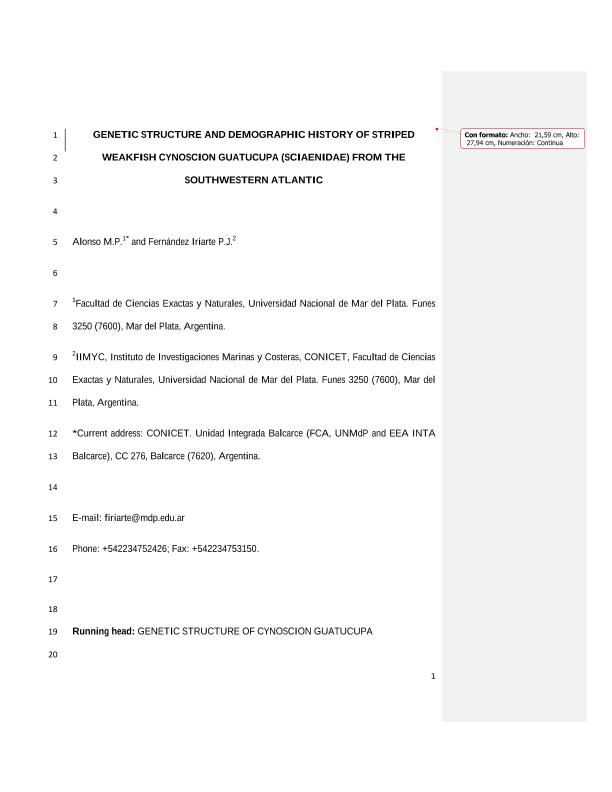Artículo
Durante el Pleistoceno se registraron en Sudamérica importantes cambios climáticos relacionados con ciclos de glaciaciones que probablemente han tenido efectos significativos en la historia evolutiva de muchas especies marinas. Para evaluar el patrón de demografía histórica y la estructura genético poblacional de la pescadilla de red (Cynoscion guatucupa) se analizó una secuencia de 401 pb del Citocromo b del ADN mitocondrial de 92 individuos de tres áreas costeras en Argentina y una de Brasil en el Atlántico sudoccidental. La diversidad haplotípica fue alta y la diversidad nucleotídica fue baja para todos los sitios de muestreo. La topología en forma de estrella en base a los haplotipos mitocondriales muestra un patrón no estructurado geográficamente en concordancia con el análisis de AMOVA. El test de Fu fue negativo y altamente significativo, mientras que el análisis de mismatch distribution produjo una distribución unimodal, indicando expansión poblacional. La tasa de mutación del Citocromo b, calibrada a partir de la comparación de la divergencia entre especies del género Cynoscion encontrados en ambos lados del Istmo de Panamá fue estimada en 0,006 sustituciones por millón de años. Para datar el cambio del tamaño poblacional a través del tiempo se usó Bayesian Skyline Plot estimando un tiempo a la coalescencia de 155.000 años. Cynoscion guatucupa mostró un patrón de acumulación de mutaciones asociado a un rápido crecimiento poblacional luego de un cuello de botella, probablemente relacionado con un evento de cambio climático ocurrido en el Pleistoceno medio-tardío. In South America, the Pleistocene was characterized by important environmental changes related to glacial cycles, which had significant effects on the evolutionary history of several marine species. To evaluate the pattern of demographic history and the genetic structure of striped weakfish Cynoscion guatucupa, a 401 bp fragment of the mitochondrial Cytochrome b gene was sequenced from 92 individuals from three coastal areas in Argentina and one in Brazil in the southwestern Atlantic. Haplotype diversity was high, whereas nucleotide diversity was low among all sampling sites. The star-like pattern was not phylogeographically structured, in agreement with the AMOVA analysis. The Fu’s test was negative and highly significant whereas the mismatch analysis yielded an unimodal distribution indicating population expansion. The mutation rate of Cytochrome b, calibrated with pairs of species of Cynoscion found on both sides of the Isthmus of Panama was estimated at 0.006 substitutions per million years. The Bayesian skyline plot was used to date changes in population size through time and revealed a coalescence time of 155,000 years. Cynoscion guatucupa exhibited a mutation accumulation pattern associated with a rapid population growth after a period of low effective population size, probably linked to climatic changes in the late Pleistocene.
Genetic structure and demographic history of striped weakfish Cynoscion guatucupa (sciaenidae) from the southwestern atlantic
Título:
Estructura genética e historia demográfica de la pescadilla de red Cynoscion guatucupa (sciaenidae) del atlántico sudoccidental
Fecha de publicación:
12/2015
Editorial:
Sociedad Argentina de Genética
Revista:
Basic and Applied Genetics
ISSN:
1666-0390
e-ISSN:
1852-6233
Idioma:
Inglés
Tipo de recurso:
Artículo publicado
Clasificación temática:
Resumen
Palabras clave:
Genetic Structure
,
Cytochrome B
,
Marine Fish
,
Pleistocene
Archivos asociados
Licencia
Identificadores
Colecciones
Articulos(IIMYC)
Articulos de INSTITUTO DE INVESTIGACIONES MARINAS Y COSTERAS
Articulos de INSTITUTO DE INVESTIGACIONES MARINAS Y COSTERAS
Citación
Alonso, María Pía; Fernandez Iriarte, Pedro Jose; Genetic structure and demographic history of striped weakfish Cynoscion guatucupa (sciaenidae) from the southwestern atlantic; Sociedad Argentina de Genética; Basic and Applied Genetics; 26; 2; 12-2015; 7-15
Compartir




